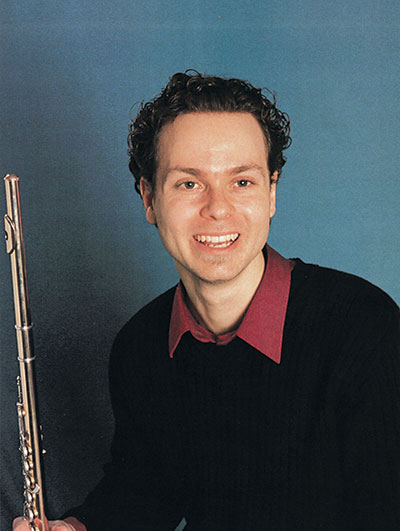Editor’s Note: Gaspar Hoyos is currently the principal flute of the Opera Nationale de Lorraine, France and is a William S. Haynes artist. This interview was originally printed in 2002.

After winning the Flute Talk competition in 1994 Gaspar Hoyos won the James Papoutsakis competition at the New England Conservatory and the National Flute Association Young Artist competition. Hoyos is a native of Bogota, Colombia and first came to the United States to attend summer flute workshops and study with Stephen Preston, Karl Kraber, Ransom Wilson, and Andras Adorjan at Wildacres, North Carolina. "I grew up listening to music and explored my parents’ record library by starting with the music of Vivaldi and Beethoven followed by Shostakovich and Messiaen. When the motion picture Amadeus was released, I bought the soundtrack and literally wore out that recording. A career in music became my dream. A good friend was a flutist, and he had the patience to play duets with me when I was just a beginner. We played duets every Saturday afternoon and again after dinner, sometimes until three in the morning, and my sightreading improved immensely."
American flutist Sarah Brown taught in Bogota and was Hoyos’s first flute teacher. From the earliest lessons she taught with Marcel Moyse’s 24 Petites Etudes and Taffanel and Gaubert’s #1 and #4 exercises. As Hoyos progressed in his studies, he wanted to study in the United States. At the University of Colorado (Boulder) he studied with Karen Yonovitz. "This was a big step, but I had such a passion to make music that I was willing to do anything for this, including leaving my country. One year later I transferred to the University of North Texas to study with Mary-Karen Clardy. She stressed breath control and releasing air in a controlled manner. After graduation I moved to Boston to study with Paula Robison, whose main concern was communicating the poetry and joy in music. Through her theatrical approach I learned to create music and communicate with an audience using the air that Clardy had stressed. I was shy and soft-spoken then, but I loved to play. Robison focused on long musical lines and sending the sound to the back of the concert hall. She also advocated interpreting music in a theatrical way. If musicians feel happiness while performing a piece, listeners will feel that same happiness.
"I played for Alain Marion in several masterclasses, and he was a good combination of Clardy and Robison. He was like Clardy, stressing the importance of the air, and like Robison in the way he expressed passion through the flute,but he also stressed the importance of tone colors prescribed by the music. An artist creates a melancholy painting using dark colors, not bright red, green, and yellow. In music the harmonics in the sound determine the musical tone color. Sometimes flutists have to sacrifice the sound quality to change the colors that add musical interest, but many American and Japanese flutists are not willing to make the sacrifice. Flutists who play with the same quality, beauty, and tone center give predictable, boring performances. Certainly teachers should not introduce tone colors to young flutists before they have developed a good basic tone. Marion’s lessons decisively changed my playing because he erased the last vestige of fear and shyness about expressing feelings and taught me to make music with air. He had a strong personality and insistently asked for more and more of everything associated with flute playing. Fantastic flutists came to his masterclasses, but they never could satisfy him. He always wanted the fortes louder and the pianos softer. He demanded perfection within the joy of making music and set a great example for all teachers with this approach.
"In a 1994 Flute Talk interview I expressed the desire to study with Raymond Guiot, and in 1997 I began two-and-a-half years with him. Guiot had been Marion’s assistant at the Paris Conservatory for many years, and they worked well together. Flutists often think of Guiot as a technique specialist, and he is fantastic in that area; but his teaching covers much more than technique. He opened many musical doors by teaching me to analyze the musical structure of a piece. After a few lessons with Guiot I was able to apply his concepts to any music. Although he is retired and lives in Quebec, he still practices every day.
"Guiot expects musicians to recognize the musical phrases and to give them shape, with a beginning, middle, and an end. He believes flutists should develop the ability to alter the tone and not give monochromatic performances. He often drew analogies between spoken words and the notes in music. If the music has patterns that repeat three to five times or motives that center on one note and return to it several times, Guiot taught that the inflections should be varied, just as inflections vary in speech. When someone repeats a comment several times, the tone of their voice grows insistent. A repeated declaration of love that is given with the same inflection may create doubt about the sincerity of the declaration. If it is stated as I love you or I love you, the message grows stronger as the inflection changes. In the Daphnis solo the opening measures center around three G# s; each should develop and change. When the solo moves on to three C#s, the same growth or progression should occur. Guiot taught this concept using the Mozart concertos which build phrases in patterns of three. By the third phrase Mozart usually makes fun of it by turning in a new direction. The concept applies to the Daphnis solo as well as all other music."
Hoyos enjoys teaching and has up to five students. "As a teacher and a coach I try to create a relaxed atmosphere for students, who generally can fix mistakes on their own. If they encounter some technical problems in the literature, I indicate specific exercises that will strengthen this aspect. If a D major scale progression is not clean, I recommend exercises in Taffanel and Gaubert or Moyse books. Many students are unenthusiastic about scales, arpeggios, and tone exercises because they find basic exercises boring. I want them to realize that technical work is essential to establish the foundation upon which all music is written. When students have mastered the D major scale in Taffanel, they are able to play it wherever it occurs in the solo literature. Without a solid technical basis it is not possible to play musically. Only when flutists have a solid technical foundation can they develop the expressive freedom to shape phrases or change tone colors, even on a whim in the middle of a performance.
"Moyse’s De la sonorite is incredible for tone work. Many flutists play the opening half-step exercise as if the two notes were unrelated. Singers would not sing the exercise that way, and I often ask students to sing the exercise. Although they may be self-conscious about singing, they should listen to recordings of singers and attend vocal performances to learn how close flute playing is to singing. Perhaps because of the physical act of holding the flute, many players forget that the flute is just a tool with which they sing. The goal is beautiful, lyrical music. When students understand that the instrument is only a means to do this, they give warmer, more expressive performances.
Vibrato is only one component of the tone equation, but it is one of the biggest challenges teachers face. The ideal is for teachers not to have to teach vibrato, which should be a natural part of the sound. If it is contained within the sound, wide pitch fluctuations do not occur. Any vibrato is incorrect if listeners notice it. A good vibrato should reflect the passion of the music, with the width and speed of the pulses varying to fit the emotional content of the piece. On some solos I use very little vibrato, and on others it is just happens as part of the passion, not as a specific choice."
The 1999 audition for the Nancy Orchestra in France was Hoyos’s first professional audition, and he admits that major pieces are easier to perform now that he has had more orchestral experience. "I did the homework for the audition by studying scores, and listened to several recorded versions of each work to know what instruments accompanied the solos. Any orchestral audition requires long preparation. Certainly flutists have to obsess about every detail in the quest for perfection, but they should also enjoy the audition process by making it a game to see how in tune they can play a passage. I remember the Nancy audition well because I enjoyed the process. Afterwards members of the audition committee stated that they heard the joy in my playing.
"In auditions most flutists play cleanly, and some perform with broad dynamic ranges. Others play incredibly fast, but those who play beautiful, musical phrases with colors that invoke images are likely to be successful. When I am on an audition committee and hear someone play well but not musically, I will indicate that on the audition form. When an audition is musical, I put the pencil down and enjoy the music.
"It is unfortunate that competitions for an orchestral position or an international competition encourage students to forget why they make music. Even though I was an international competition winner, I now believe that the goal of wining a prize should not be the primary motivation as flutists practice or perform. It is pointless to just work for first prize by playing loudly or by attempting to perform better than other contestants on a Bach sonata, a Mozart concerto, or the Nielsen concerto. If a monetary goal or a prize leads to faster or louder playing, or resorts to choreography or a great hairdo to win, these will be the results. Competitions often skew our values because so many performances seem to be a way to display expertise on the flute rather than to find the beauty in the music.
Hoyos particularly enjoys French music by Debussy, Ravel, and others. "It is pure joy to sit in the orchestra and play fine music that requires such wonderful tone colors. Performing Strauss is also an incredible experience, but it is different because flutists sit in the middle of the orchestra under a big, weighty Romantic orchestral sound, while with French music flutists float above the orchestra."
Hoyos prefers flute headjoints that have resistance instead of a free-blowing mouthpiece that is easier to play. "Manufacturers always provide flutes with the qualities that are in demand. Currently this means headjoints with a bright sound and a compact, cutting edge. It is more difficult to shape phrases and produce different tone colors on these headjoints, and I find them a bit monochromatic."
Hoyos travels and performs around the world and speaks French, Italian, Spanish, and English. He urges students to be "aware of flute events and trends around the world, especially in France, where such a long flute tradition exists. I urge them to experience the Parisian flute community first-hand because reading about Parisian music-making or listening to recordings is not the same as living in a culture. I recommend that students live and study in Paris for at least one year. Besides fantastic teachers and players, the experience will open doors to personal and musical development. With the paintings at the Louvre, fantastic architecture, and excellent food and wine, in addition to the joy of making music in this invigorating place, all flutists will be richer after living and studying there."







